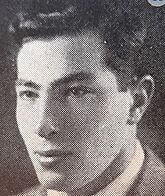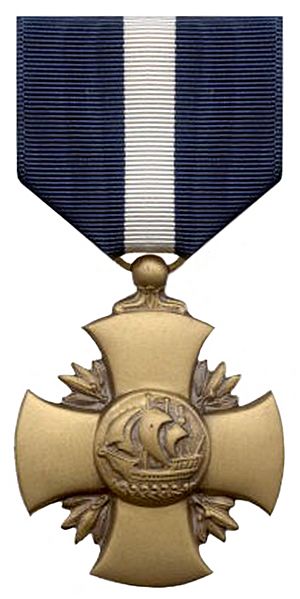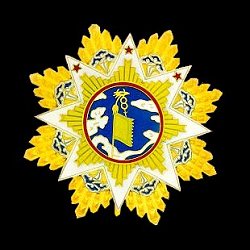Robert Halperin facts for kids

Halperin in his youth
|
||||||||||||||||||||
| Personal information | ||||||||||||||||||||
|---|---|---|---|---|---|---|---|---|---|---|---|---|---|---|---|---|---|---|---|---|
| Born | January 26, 1908 Chicago, Illinois, U.S. |
|||||||||||||||||||
| Died | May 8, 1985 (aged 77) Palm Springs, California, U.S. |
|||||||||||||||||||
| Resting place | Arlington National | |||||||||||||||||||
| Education | Notre Dame, Wisconsin | |||||||||||||||||||
| Occupation |
|
|||||||||||||||||||
| Spouse(s) | Margaret | |||||||||||||||||||
|
Medal record
|
||||||||||||||||||||
Robert "Bob" Halperin (born January 26, 1908 – died May 8, 1985), also known as "Buck", was an amazing American. He was a successful business leader and a highly decorated officer in the U.S. Navy during World War II. He was also a talented sailor, winning a bronze medal at the Olympic Games and a gold medal at the Pan American Games.
Bob Halperin helped start the famous company Lands' End. He also led his family's business, the Commercial Light Company in Chicago. Before all that, he was a college and professional football player for the Brooklyn Dodgers. During World War II, he was a brave scout who helped guide troops onto beaches. He became one of Chicago's most honored veterans.
Contents
About Bob Halperin's Life
Bob Halperin was born in Chicago, Illinois. His father, Aaron, came to the United States from Kiev in the 1890s. Aaron started the Commercial Light Co. in 1915, an electrical company in Chicago.
Robert married Margaret Stralka, and they had three sons: Thomas, Patrick, and Daniel. Bob lived in Chicago and later in Palm Springs, California.
Bob's Football Career
Bob Halperin was a great athlete from a young age. He was the captain of his high school football team at Oak Park and River Forest High School.
In college, he played football as a quarterback for the University of Notre Dame under the famous coach Knute Rockne. Later, he played for the University of Wisconsin and graduated in 1932.
After college, Bob played professional football in the National Football League (NFL) for the Brooklyn Dodgers. He later coached football at St. Patrick High School.
Bob Halperin was one of Chicago's most honored sailors from World War II.
He joined the United States Navy in 1942 when he was 34 years old. He started as a seaman and rose to the rank of commander. He trained in a secret program to become a "Navy Scout & Raider." This group was a very early version of today's Navy Seals.
Their job was super important and dangerous: they had to find landing beaches at night, check for dangers, and then guide attacking troops and their boats safely to shore. Bob Halperin was in charge of 14 scout boats. He was one of the first Americans to land in France on D-Day. He also served in battles in Sicily, Italy, North Africa, and the Pacific.
Awards and Honors
Bob Halperin received many awards for his bravery:
- The Navy Cross
- The Silver Star
- Two Bronze Stars
- The Yun Hui Clouded Banner, which is the highest honor from the Nationalist Chinese government.
Hero in North Africa
In November 1942, during the invasion of North Africa, Bob Halperin showed incredible courage. He sailed his scout ship in complete darkness to French Morocco. He found and marked the landing beaches and guided troops to their targets, even while enemy planes were shooting at them. He was the first American in that invasion to capture two enemy officers. For his amazing bravery and skill, he received a presidential award and the Navy Cross.
Actions in Sicily and Normandy
He was promoted to lieutenant commander for his actions during the attack on Scoglitti in Sicily in 1943.
During the Normandy Invasion in June 1944 (D-Day), he guided the first two waves of attack troops to the beaches. He did this even though the enemy was fighting back strongly. He also saved two men from drowning. The Chicago Tribune newspaper said he was "one of the first Americans to go ashore in France—perhaps, the first—on D-Day." He earned a Bronze Star for his excellent work and calm judgment.
Service in China
From 1944 to 1945, Bob Halperin led a secret U.S. Naval Unit in China. They worked behind enemy lines against the Japanese. His team trained 2,500 Chinese fighters, helped kill 1,300 enemy troops, and rescued 16 U.S. pilots. Even though they were outnumbered, they fought bravely. For his courage, he received a Silver Star from the American military.
The Nationalist Chinese government gave him their highest honor, the Yun Hui "Order of the Cloud and Banner." This award is usually given to very high-ranking officers like Admirals and Generals.
Bob's Sailing Success
Bob Halperin was a talented sailor. He sailed for the Chicago Yacht Club. In 1959, he won the North American Star Championship.
Olympic Medal Winner
At the 1960 Summer Olympics in Italy, when he was 52 years old, he won a bronze medal for the United States. He competed in the Star class sailboat race with his teammate William Parks. Their boat was named Shrew II.
Pan-American Gold Medal
In 1963, he won a gold medal at the 1963 Pan American Games in Brazil. He sailed with Richard Stearns on a boat called Ninotchka.
Honors for Sailing
There is a special award called the Buck Halperin Trophy. It is given at the World Championships to the sailing team with the best score.
In 1989, Bob Halperin was honored by being inducted into the Chicagoland Sports Hall of Fame.
Business Ventures
Leading Commercial Light
Bob Halperin used his electrical engineering skills to become a leader at Commercial Light Company. This large electrical business was started by his father in 1915. He became the company's President in 1959 and later its chairman. The company worked on big projects in Chicago, like the John Hancock Center, O'Hare International Airport, and Wrigley Field.
Co-founding Lands' End
In 1963, Bob Halperin helped start the well-known company Lands' End. He teamed up with his friend Gary Comer, fellow sailor and Pan-American gold medalist Richard Stearns, and two of Stearns' employees.
His Final Years
Bob Halperin passed away on May 8, 1985, in Palm Springs, California, at age 77. He is buried at Arlington National Cemetery with his wife.
See also
- List of Jews in sailing





